In Vivo Antifungal Activity of South African Medicinal Plant Extracts against Fusarium Pathogens and Their Phytotoxicity Evaluation
Abstract
1. Introduction
2. Results
2.1. Antifungal Activity against Maize Seeds Inoculated with Fusarium Pathogens
2.2. Phytotoxicity on Maize Seed Germination
2.3. Antifungal Activity of Plant Extracts against Pathogen Inoculated on Maize Seedlings
2.4. Phytotoxicity on Maize Seedling Growth
3. Discussion
4. Materials and Methods
4.1. Collection and Disinfection of Maize Seeds
4.2. Collection of Plant Materials
4.3. Preparation of Plant Extracts
4.4. Preparation of Fusarium Pathogens
4.5. Antifungal Activity of Plant Extracts
4.5.1. In Vivo Activity against Maize Seed Inoculated with Pathogens
4.5.2. In Vivo Activity against Pathogen Inoculated on Maize Seedlings
4.6. Phytotoxicity Evaluation of Plant Extracts
4.6.1. Maize Seed Germination
4.6.2. Maize Seedling Growth
4.7. Statistical Analysis
5. Conclusions
Author Contributions
Funding
Acknowledgments
Conflicts of Interest
References
- Smale, M.; Bellon, M.R.; Gomez, J.A.A. Maize diversity, variety attributes, and farmers’ choices in South eastern Guanajuato, Mexico. Econ. Dev. Cult. Chang. 2001, 50, 201–225. [Google Scholar] [CrossRef]
- Chulze, S.N. Strategies to reduce mycotoxin levels in maize during storage: A review. Food Addit. Contam. Part A 2010, 27, 651–657. [Google Scholar] [CrossRef] [PubMed]
- Chaudhary, A.R. Maize in Pakistan Faisalabad: Punjab Agricultural Research Coordination Board, 1st ed.; University of Agriculture Faisalabad: Faisalabad, Pakistan, 1983. [Google Scholar]
- Pimentel, D.; Patzek, T.W. Ethanol production using corn, switchgrass, and wood; Biodiesel production using soybean and sunflower. Nat. Resour. Res. 2005, 14, 65–76. [Google Scholar] [CrossRef]
- Muimba-Kankolongo, A. Food Crop Production by Smallholder Farmers in Southern Africa: Challenges and Opportunities for Improvement, 1st ed.; Academic Press: Cambridge, MA, USA, 2018. [Google Scholar]
- Abate, T.; Fisher, M.; Abdoulaye, T.; Kassie, G.T.; Lunduka, R.; Marenya, P.; Asnake, W. Characteristics of maize cultivars in Africa: How modern are they and how many do smallholder farmers grow? Agric. Food Secur. 2017, 6, 1–17. [Google Scholar] [CrossRef] [PubMed]
- Mungai, L.M.; Snapp, S.; Messina, J.P.; Chikowo, R.; Smith, A.; Anders, E.; Richardson, R.B.; Li, G. Smallholder farms and the potential for sustainable intensification. Front. Plant Sci. 2016, 7, 1720. [Google Scholar] [CrossRef]
- Singh, R.; Kumar, P.; Woodhead, T. Smallholder farmers in India: Food Security and Agricultural Policy, 1st ed.; FAO Regional Office for Asia and the Pacific: Bangkok, Thailand, 2002. [Google Scholar]
- Baiphethi, M.N.; Jacobs, P.T. The contribution of subsistence farming to food security in South Africa. Agrekon 2009, 48, 459–482. [Google Scholar] [CrossRef]
- Salami, A.; Kamara, A.B.; Brixiova, Z. Smallholder Agriculture in East Africa: Trends, Constraints and Opportunities; Working Papers Series No. 105; African Development Bank Group: Tunis, Tunisia, 2010. [Google Scholar]
- Crush, J.; Hovorka, A.; Tevera, D. Food security in southern African cities: The place of urban agriculture. Prog. Dev. Stud. 2011, 11, 285–305. [Google Scholar] [CrossRef]
- Sperling, L.; Remington, T.; Haugen, J.M.; Nagoda, S. Addressing Seed Security in Disaster Response: Linking Relief with Development, Overview, 1st ed.; International Center for Tropical Agriculture (CIAT): Cali, CA, USA, 2004. [Google Scholar]
- McGuire, S.; Sperling, L. Seed system smallholder farmers use. Food Secur. 2016, 8, 179–195. [Google Scholar] [CrossRef]
- Kusena, K.; Wynberg, R.; Mujaju, C. Do smallholder farmer-led seed systems have the capacity to supply good-quality, fungal-free sorghum seed? Agric. Food Secur. 2017, 6, 52. [Google Scholar] [CrossRef]
- Govender, V.; Aveling, T.A.S.; Kritzinger, Q. The effect of traditional storage methods on germination and vigour of maize (Zea mays L.) from northern KwaZulu-Natal and southern Mozambique. S. Afr. J. Bot. 2008, 74, 190–196. [Google Scholar] [CrossRef]
- Munkvold, G.P.; Desjardins, A.E. Fumonisins in maize: Can we reduce their occurrence? Plant Dis. 1997, 81, 556–565. [Google Scholar] [CrossRef] [PubMed]
- Munkvold, G.P.; Carlton, M.W. Influence of inoculation method on systemic Fusarium moniliforme infection of maize plants grown from infected seeds. Plant Dis. 1997, 81, 211–216. [Google Scholar] [CrossRef] [PubMed]
- Marasas, W.F.O.; Nelson, P.E.; Toussoun, T.A. Toxigenic Fusarium Species: Identity and Mycotoxicology; The Pennsylvania State University Press: State College, PA, USA, 1984. [Google Scholar]
- Nelson, P.E.; Desjardins, A.E.; Plattner, R.D. Fumonisins, mycotoxins produced by Fusarium species: Biology, chemistry and significance. Annu. Rev. Phytopathol. 1993, 31, 233–252. [Google Scholar] [CrossRef] [PubMed]
- Desjardin, A.E. Fusarium Mycotoxins: Chemistry, Genetics and Biology; American Phytopathological Society (APS Press): Saint Paul, MN, USA, 2006; pp. 335–336. [Google Scholar]
- Marasas, W.F.O.; Wehner, F.C.; Van Schlkwyk, D.J. Mycoflora of corn produced in human oesophageal cancer areas in Transkei. Physiopathology 1981, 71, 792–796. [Google Scholar] [CrossRef]
- Sun, G.; Wang, S.; Hu, X.; Su, J.; Huang, T.; Yu, J. Fumonisin B1. Contamination of home-grown corn in high-risk areas for oesophageal and liver cancer in china. Food Addit. Contam. A 2007, 24, 181–185. [Google Scholar] [CrossRef]
- Cumagun, C.J.R.; Ramos, J.S.; Dimaano, A.O.; Munaut, F.; Van Hove, F. Genetic characteristics of Fusarium verticilloides from corn in the Philippines. J. Gen. Plant Pathol. 2009, 75, 405–412. [Google Scholar] [CrossRef]
- Rocha, M.E.; Freire, F.D.; Maia, F.E.; Guedes, M.I.; Rondina, D. Mycotoxins and their effects on human and animal health. Food Control 2014, 36, 159–165. [Google Scholar] [CrossRef]
- Cherry, A.J.; Bantino, A.; Djegui, D.; Lomers, C. Suppression of the stem borer Sesamia calamistis (Lepidoptera: Noctuidae) in maize following seed dressing, topical application and stem injection with African isolates of Beauveria bassiana. Int J. Pest. Manag. 2005, 50, 67–73. [Google Scholar] [CrossRef]
- Isman, M.B. Botanical insecticides, deterrents, and repellents in modern agriculture and an increasingly regulated world. Annu. Rev. Entomol. 2006, 51, 45–66. [Google Scholar] [CrossRef]
- Sukanya, S.L.; Yamini, D.; Fathima, S.K. Eco-friendly management of Pyricularia oryzae, the causal agent of blast of paddy. Curr. Bot. 2011, 2, 46–49. [Google Scholar]
- Chopra, R.N.; Nayer, S.L.; Chopra, I.C. Glossary of Indian Medicinal Plants, 3rd ed.; Council of Scientific and Industrial Research: New Delhi, India, 1992. [Google Scholar]
- Harborne, J.B.; Baxter, H.; Moss, G.P. Phytochemical Dictionary: A Handbook of Bioactive Compounds from Plants; Taylor & Francis: London, UK, 1995. [Google Scholar]
- Ahmad, I.; Beg, A.Z. Antimicrobial and phytochemical studies on 45 Indian medicinal plants against multi-drug resistant human pathogens. J. Ethnopharmacol. 2001, 74, 113–123. [Google Scholar] [CrossRef]
- Masika, P.J.; Afolayan, A.J. Antimicrobial activity of some plants used for the treatment of livestock disease in the Eastern Cape, South Africa. J. Ethnopharmacol. 2002, 83, 129–134. [Google Scholar] [CrossRef]
- Khan, Z.S.; Nasreen, S. Phytochemical analysis, antifungal activity and mode of action of methanol extracts from plants against pathogens. J. Agric. Sci. Technol. 2010, 6, 793–805. [Google Scholar]
- Seepe, H.A.; Amoo, S.O.; Nxumalo, W.; Adeleke, R.A. Antifungal activity of medicinal plant extracts for potential management of Fusarium pathogens. Res. Crops 2019, 20, 399–406. [Google Scholar]
- Seepe, H.A.; Amoo, S.O.; Nxumalo, W.; Adeleke, R.A. Sustainable use of thirteen South African medicinal plants for the management of crop diseases caused by Fusarium species–An in vitro study. S. Afr. J. Bot. 2020, 130, 456–464. [Google Scholar] [CrossRef]
- Khan, A.V.; Khan, A.A.; Shukla, I. In vitro antibacterial potential of Melia azedarach crude leaf extracts against some human pathogenic bacterial strains. Ethnobot. Leafelts 2008, 12, 39–45. [Google Scholar]
- Desjardins, A.E. Gibberella from A (venaceae) to Z (eae). Annu. Rev. Phytopathol. 2003, 41, 177–198. [Google Scholar] [CrossRef]
- Summerell, B.A.; Leslie, J.F. Fifty years of Fusarium: How could nine species have ever been enough? Fungal Divers. 2011, 50, 135–144. [Google Scholar] [CrossRef]
- Gonzalez, H.H.L.; Resnik, S.L.; Boca, R.T.; Marasas, W.F.O. Mycoflora of Argentinean corn harvested in the main production area in 1990. Mycopathologia 1995, 130, 29–36. [Google Scholar] [CrossRef]
- Chulze, S.; Ramirez, M.L.; Farnochi, M.C.; Pascale, M.; Visconti, A.; March, G. Fusarium and fumonisins occurrence in Argentinean corn at different ear maturity stages. J. Agric. Food Chem. 1996, 44, 2797–2801. [Google Scholar] [CrossRef]
- Kedera, C.J.; Plattner, R.D.; Desjardins, A.E. Incidence of Fusarium spp and levels of fumonisins in maize in western Kenya. Appl. Environ. Microbiol. 1999, 65, 41–44. [Google Scholar] [CrossRef] [PubMed]
- Aguín, O.; Cao, A.; Pintos, C.; Santiago, R.; Mansilla, P.; Butrón, A. Occurrence of Fusarium species in maize kernels grown in northwestern Spain. Plant Pathol. 2014, 63, 946–951. [Google Scholar] [CrossRef]
- Kossou, D.K.; Aho, N. Stockage et Conservation des Grains Alimentaires Tropicaux: Principes et Pratiques; Les Editions du Flamboyant: Cotonou, Benin, 1993. [Google Scholar]
- Mokoena, M.P.; Chelule, P.K.; Gqaleni, N. Reduction of fumonisin B1 and zearalenone by lactic acid bacteria in fermented maize meal. J. Food Prot. 2005, 68, 2095–2099. [Google Scholar] [CrossRef] [PubMed]
- Nukenine, E.N.; Tofel, H.K.; Adler, C. Comparative efficacy of NeemAzal® and local botanicals derived from Azadirachta indica and Plectranthus glandulosus against Sitophilus zeamais on maize. J. Pest Sci. 2011, 84, 479–486. [Google Scholar] [CrossRef]
- Danga, S.P.Y.; Nukenine, E.N.; Fotso, G.T.; Adler, C. Use of NeemPro®, a neem product to control maize weevil Sitophilus zeamais (Motsch.) (Coleoptera: Curculionidae) on three maize varieties in Cameroon. Agric. Food Secur. 2015, 4, 18. [Google Scholar] [CrossRef]
- Snyder, L.R. Classification of the solvent properties of common liquids. J. Chrom. 1978, 16, 223–234. [Google Scholar] [CrossRef]
- Rishi, K.; Singh, R. Chemical components and insecticidal properties of Bakain (Melia azedarach L.)—A Review. Agric. Rev. 2003, 24, 101–115. [Google Scholar]
- Suresh, K.; Deepa, P.; Harisaranraj, R.; Vaira, A.V. Antimicrobial and phytochemical investigation of the leaves of Carica papaya L., Cynodon dactylon L. Pers., Euphorbia Hirta L., Melia azedarach L. and Psidium guajava L. Ethnobot. Leaflets 2008, 12, 1184–1191. [Google Scholar]
- Sultana, S.; Akhtar, N.; Asif, H.M. Phytochemical screening and antipyretic effects of hydro-methanol extract of Melia azedarach leaves in rabbits. Bangladesh J. Pharmacol. 2013, 8, 214–217. [Google Scholar] [CrossRef]
- Pegel, K.A.; Rogers, C.B. The characterization of mollic acid-3β-D-xyloside and its genuine aglycon mollic acid, two novel 1α-hydroxycycloartenoids from Combretum molle. J. Chem. Soc. Perkin Trans. 1 1985, 1, 1711–1715. [Google Scholar] [CrossRef]
- Asres, K.; Bucar, F.; Edelsbrunner, S.; Kartnig, T.; Höger, G.; Thiel, W. Investigations on antimycobacterial activity of some Ethiopian Medicinal Plants. Phytother. Res. 2001, 15, 323–326. [Google Scholar] [CrossRef] [PubMed]
- Martini, N.D.; Katerere, D.R.P.; Eloff, J.N. Biological activity of five antibacterial flavonoids from Combretum erythrophyllum (Combretaceae). J. Ethnopharmacol. 2004, 93, 207–212. [Google Scholar] [CrossRef] [PubMed]
- Carpinella, M.C.; Giorda, L.M.; Ferrayoli, C.G.; Palacios, S.M. Antifungal effects of different organic extracts from Melia azedarach L. on phytopathogenic fungi and their isolated active components. J. Agric. Food Chem. 2003, 51, 2506–2511. [Google Scholar] [CrossRef] [PubMed]
- Carpinella, M.C.; Ferrayolic, C.G.; Palacios, S.M. Antifungal synergistic effect of scopoletin, a hydroxycoumarin isolated from Melia azedarach L. fruits. J. Agric. Food Chem. 2005, 53, 2922–2927. [Google Scholar] [CrossRef] [PubMed]
- Glotter, E.; Kirson, I.; Abraham, A.; Lavie, D. Constituents of Withania somnifera Dun—XIII: The withanolides of chemotype II. Tetrahedron 1973, 29, 1353–1364. [Google Scholar] [CrossRef]
- Devi, P.U.; Sharada, A.C.; Solomon, F.E. Antitumor and radiosensitizing effects of Withania somnifera (Ashwagandha) on a transplantable mouse tumor, Sarcoma-180. Indian J. Exp. Biol. 1993, 31, 607–611. [Google Scholar]
- Aberkane, A.; Cuenca-Estrella, M.; Gomez-Lopez, A.; Petrikkou, E.; Mellado, E.; Monzon, A.; Rodriguez Tudela, J.L. Comparative evaluation of two different methods of inoculums preparation for antifungal susceptibility testing of filamentous fungi. J. Antimicrob. Chemother. 2002, 50, 719–722. [Google Scholar] [CrossRef]
- Mahlo, S.M.; McGaw, L.J.; Eloff, J.N. Antifungal activity of leaf extracts from South African trees against plant pathogens. Crop Prot. 2010, 29, 1529–1533. [Google Scholar] [CrossRef]
- Ledingham, R.J.; Atkinson, T.G.; Horricks, J.S.; Mills, J.T.; Piening, L.J.; Tinline, R.D. Wheat losses due to common root rot in the prairie provinces of Canada. Can. Plant Dis. Surv. 1973, 53, 113–122. [Google Scholar]
- Saseetharan, N.H.M.; Zakaria, L. Occurrence of Fusarium spp. on vegetable crops and assessment of their pathogenicity. Pertanika J. Trop. Agric. Sci. 2014, 37, 445–455. [Google Scholar]
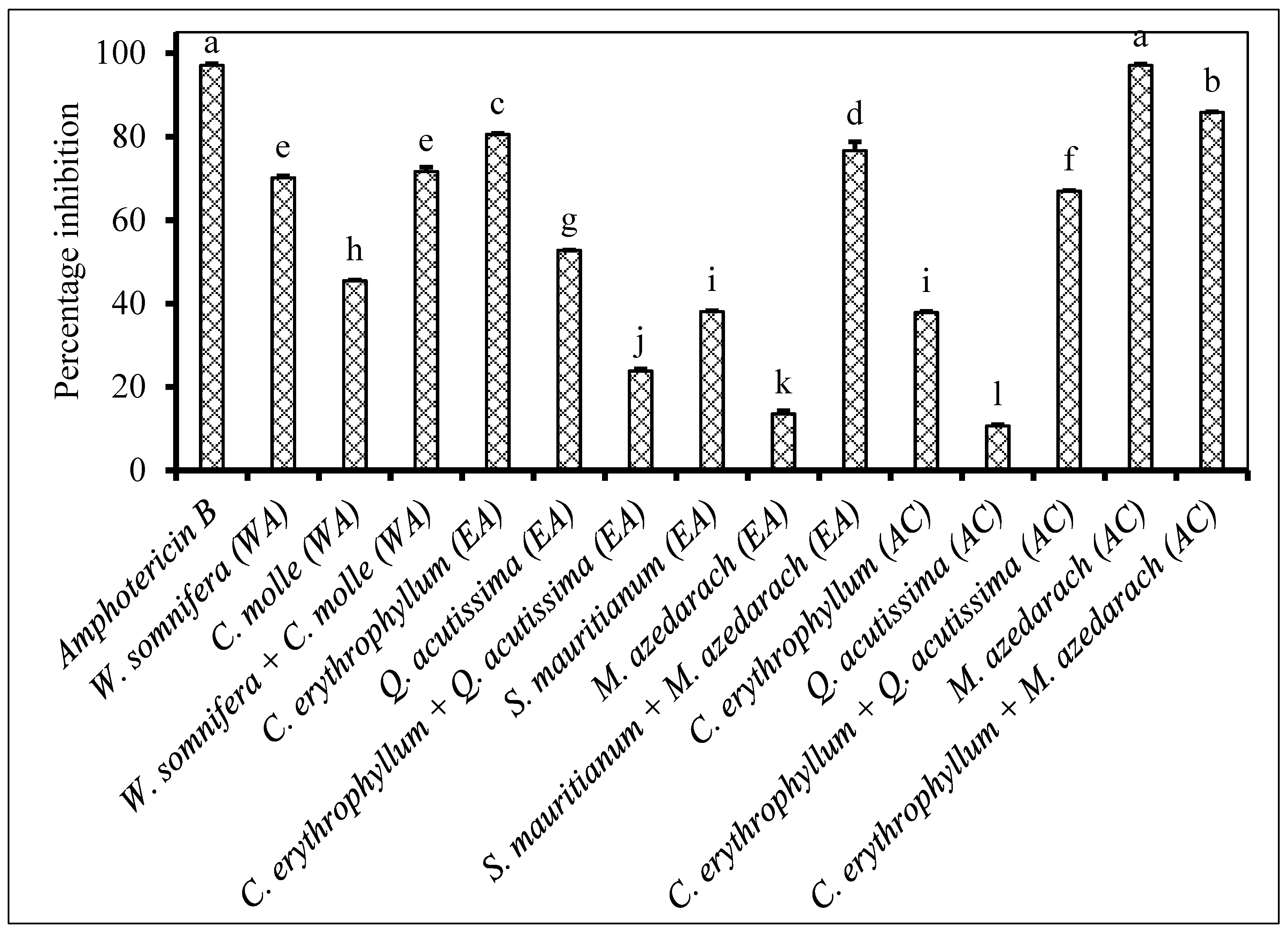


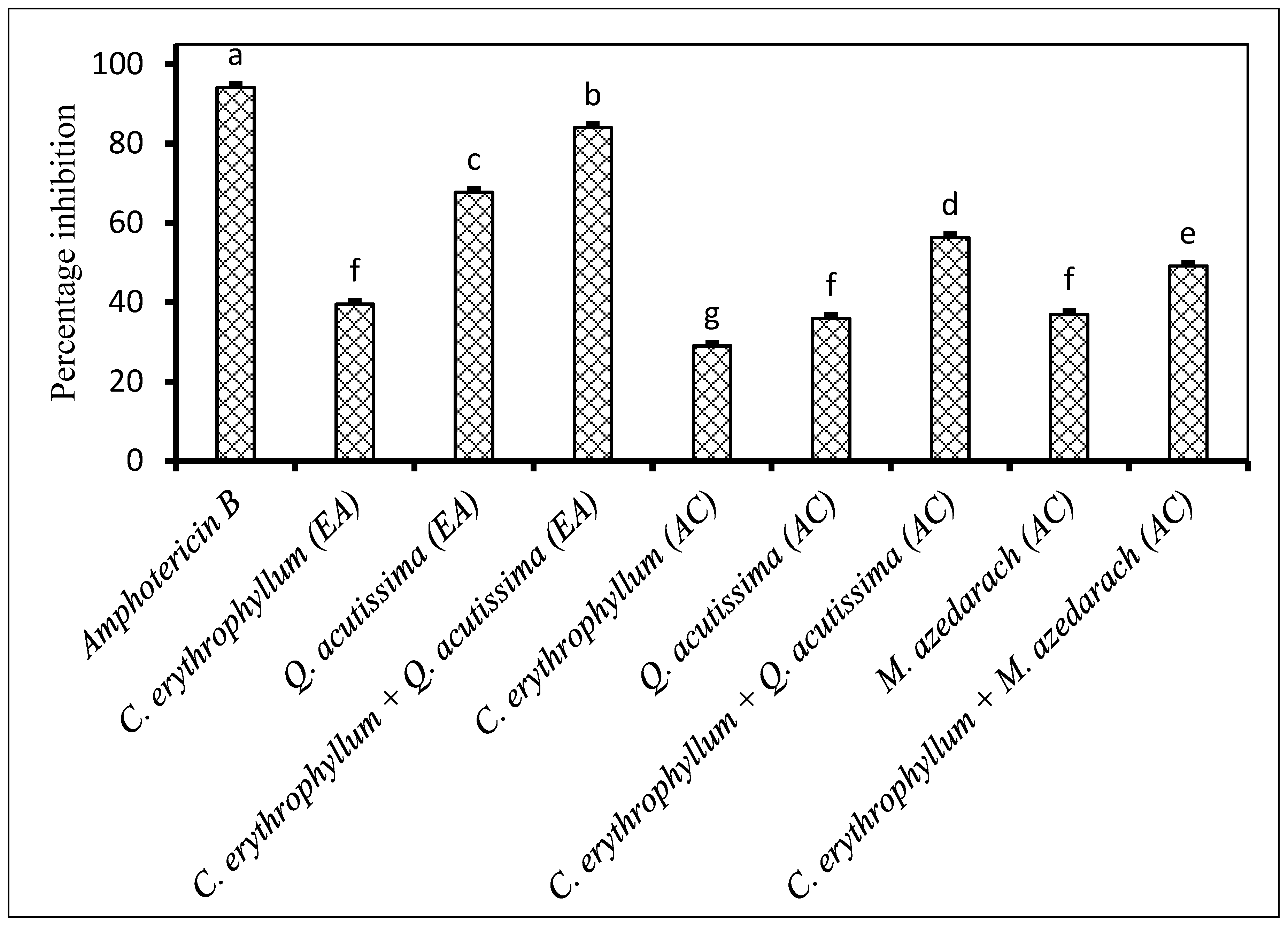
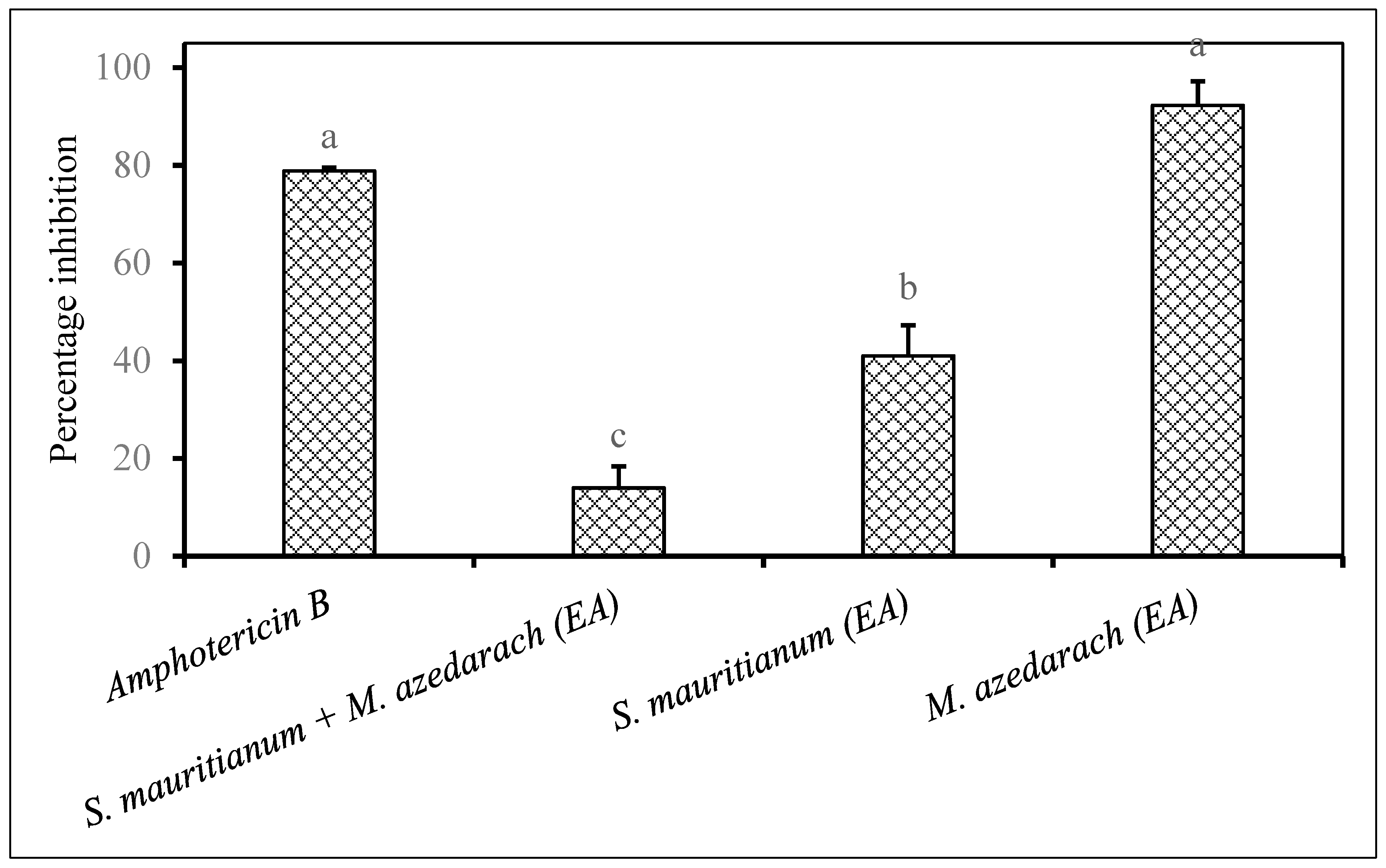
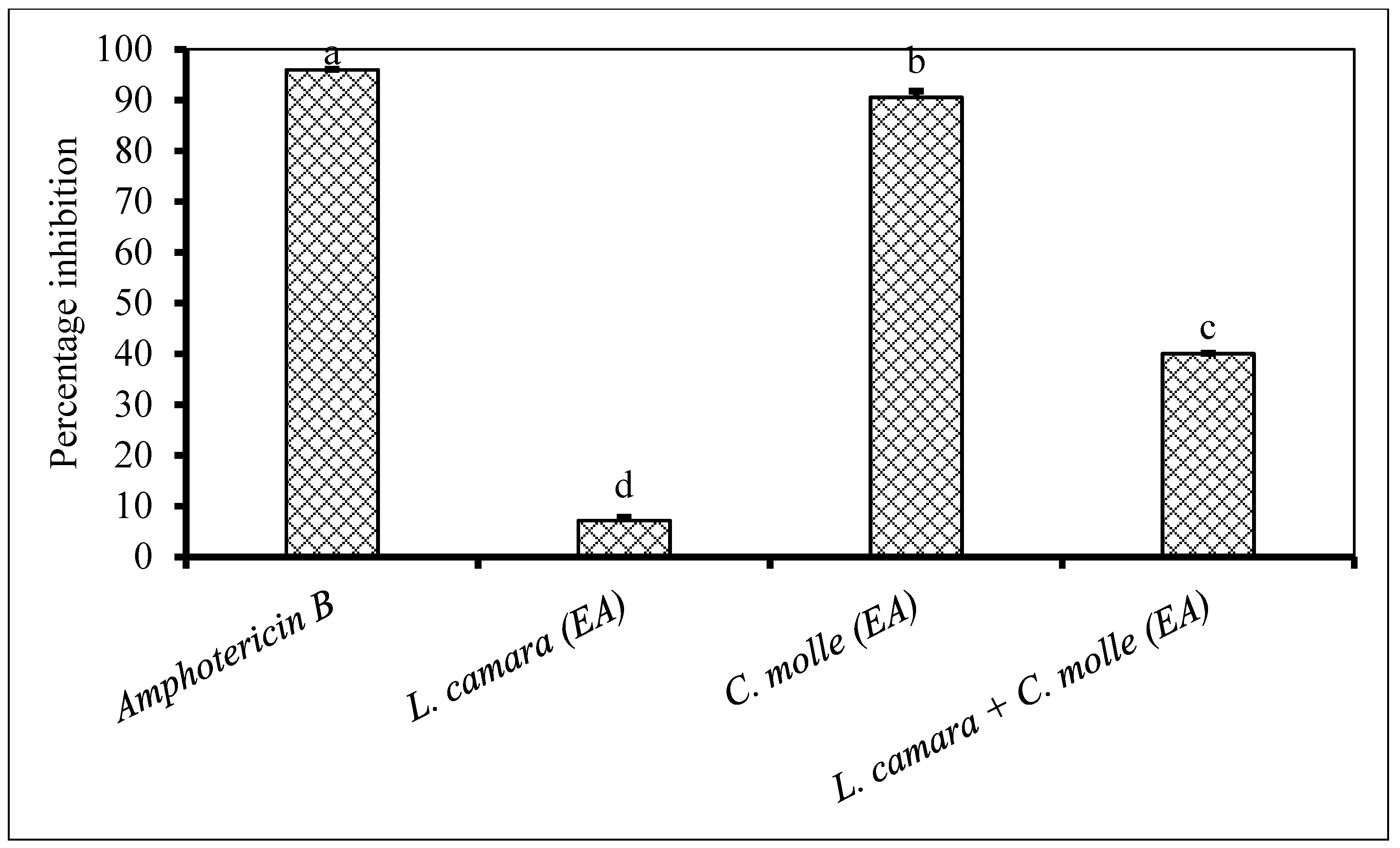
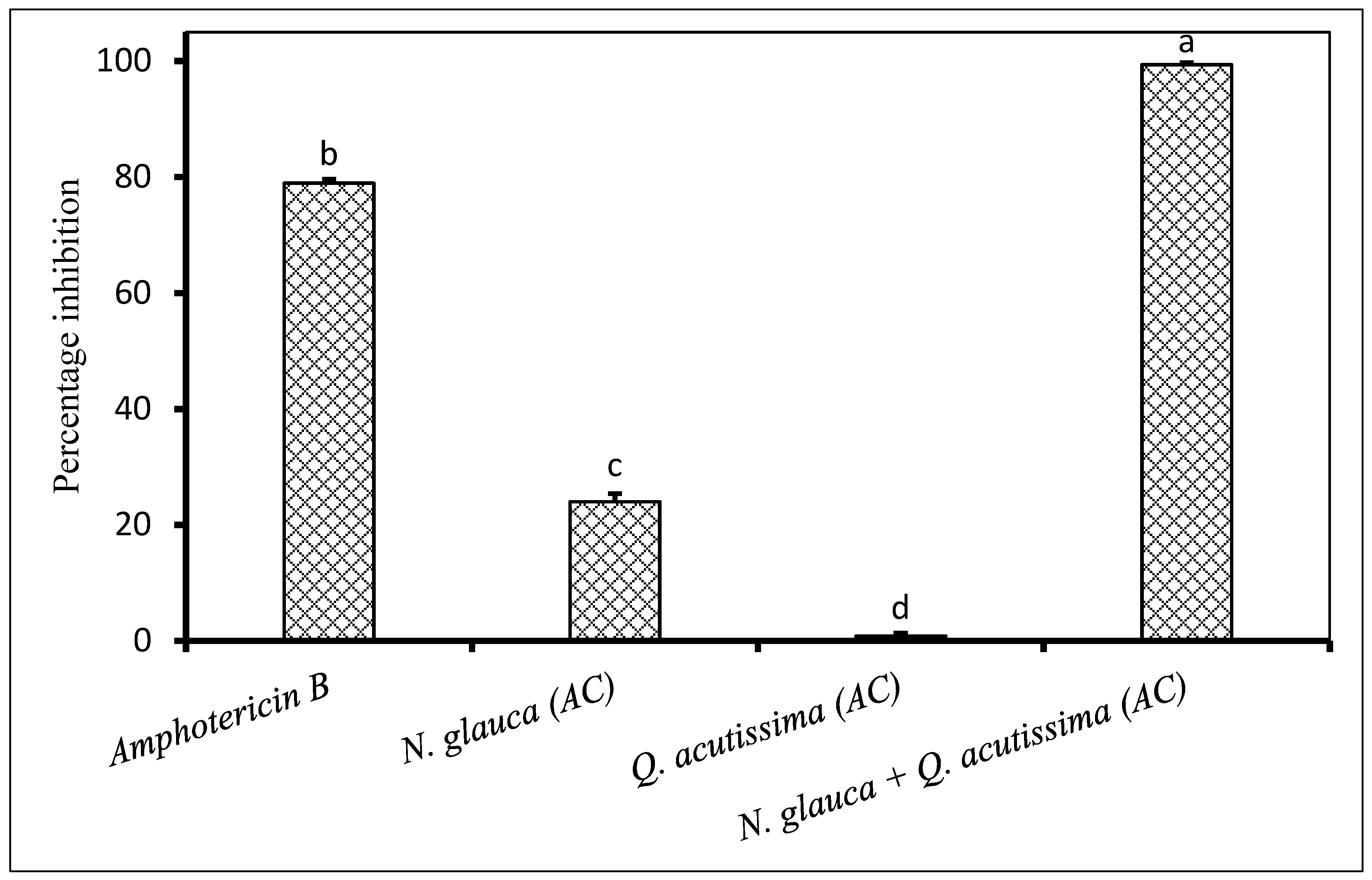
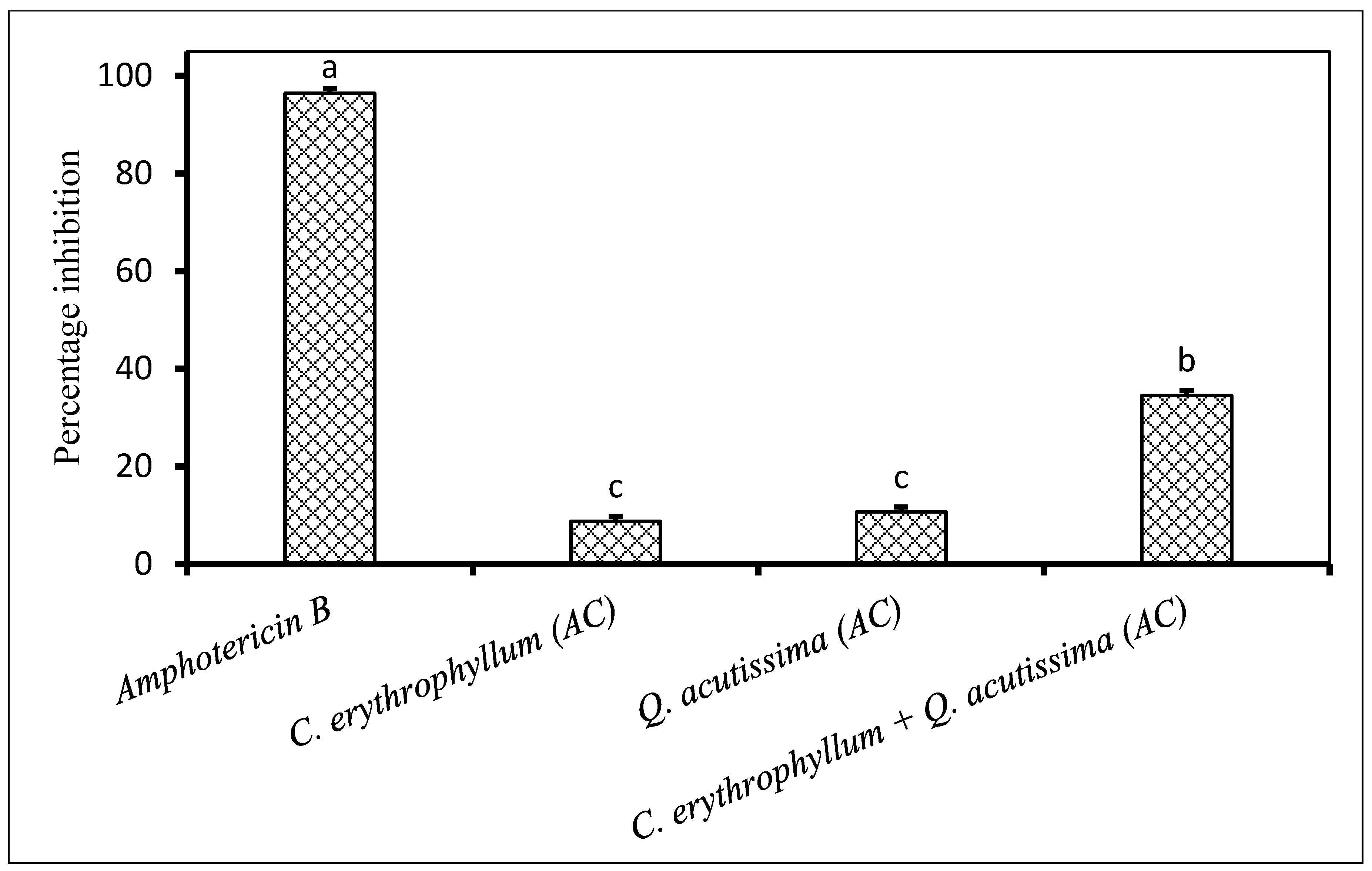
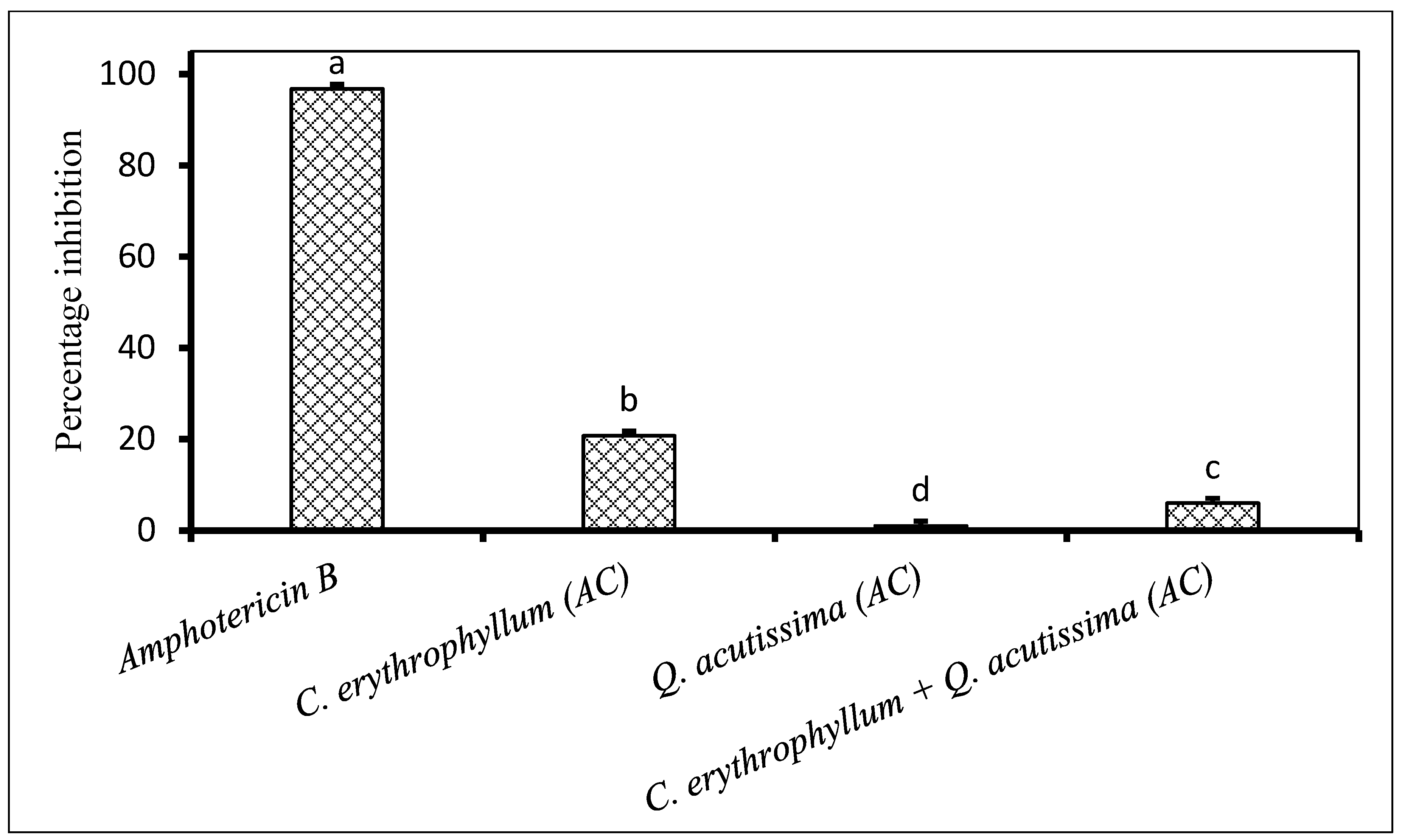
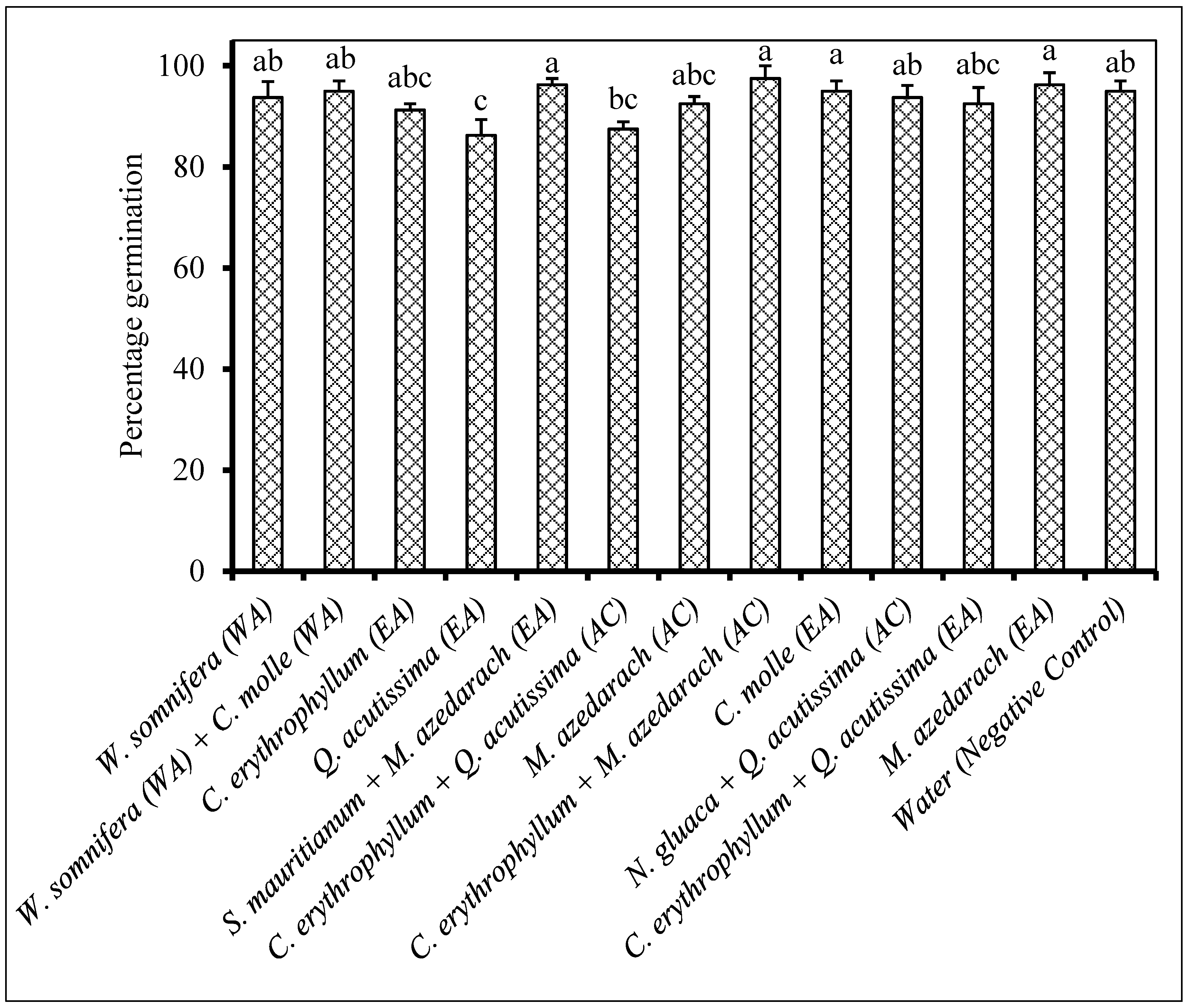
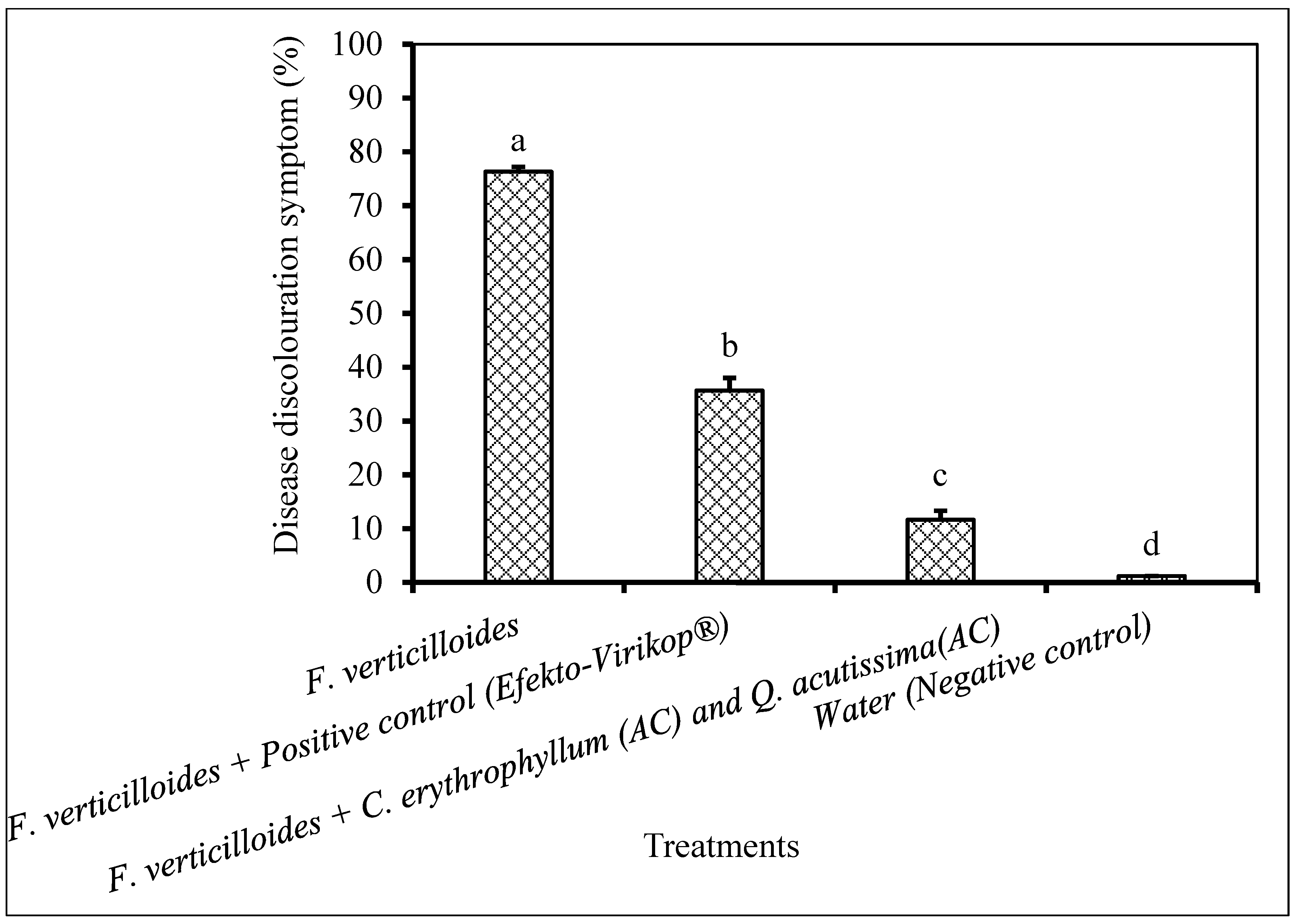
| Growth Parameters | Negative Control | C. erythrophyllum and Q. acutissima Acetone Extract | R.I (%) |
|---|---|---|---|
| Plant height (mm) | 320.3 ± 34.80 ns | 319.8 ± 19.82 ns | −0.14 |
| Chlorophyll content (SPAD) | 36.5 ± 2.30 ns | 38.0 ± 1.49 ns | 4.14 |
| Number of leaves | 6.6 ± 0.63 ns | 6.2 ± 0.32 ns | −5.85 |
| Dry shoot mass (g) | 9.3 ± 1.12 ns | 9.2 ± 1.03 ns | −0.19 |
| Stem diameter (mm) | 9.85 ± 1.14 ns | 8.82 ± 0.58 ns | −10.41 |
| Dry root mass (g) | 4.32 ± 1.54 ns | 4.55 ± 0.47 ns | 5.48 |
Publisher’s Note: MDPI stays neutral with regard to jurisdictional claims in published maps and institutional affiliations. |
© 2020 by the authors. Licensee MDPI, Basel, Switzerland. This article is an open access article distributed under the terms and conditions of the Creative Commons Attribution (CC BY) license (http://creativecommons.org/licenses/by/4.0/).
Share and Cite
Seepe, H.A.; Lodama, K.E.; Sutherland, R.; Nxumalo, W.; Amoo, S.O. In Vivo Antifungal Activity of South African Medicinal Plant Extracts against Fusarium Pathogens and Their Phytotoxicity Evaluation. Plants 2020, 9, 1668. https://doi.org/10.3390/plants9121668
Seepe HA, Lodama KE, Sutherland R, Nxumalo W, Amoo SO. In Vivo Antifungal Activity of South African Medicinal Plant Extracts against Fusarium Pathogens and Their Phytotoxicity Evaluation. Plants. 2020; 9(12):1668. https://doi.org/10.3390/plants9121668
Chicago/Turabian StyleSeepe, Hlabana A., Kafua E. Lodama, René Sutherland, Winston Nxumalo, and Stephen O. Amoo. 2020. "In Vivo Antifungal Activity of South African Medicinal Plant Extracts against Fusarium Pathogens and Their Phytotoxicity Evaluation" Plants 9, no. 12: 1668. https://doi.org/10.3390/plants9121668
APA StyleSeepe, H. A., Lodama, K. E., Sutherland, R., Nxumalo, W., & Amoo, S. O. (2020). In Vivo Antifungal Activity of South African Medicinal Plant Extracts against Fusarium Pathogens and Their Phytotoxicity Evaluation. Plants, 9(12), 1668. https://doi.org/10.3390/plants9121668






